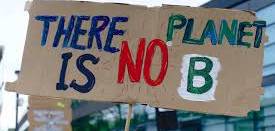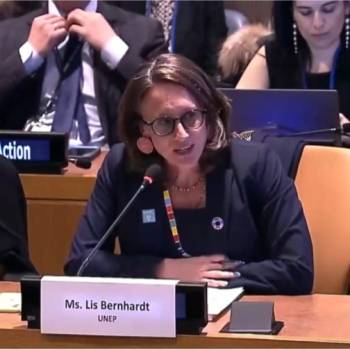
- The latest UNEP Emissions Gap report reveals that the new and updated Nationally Determined Contributions project only a 7.5% drop in emissions forecast for 2030, while 55% is needed to reach the Paris target of 1.5 ° C
- The latest climate promises for 2030 put the world on track for a temperature rise of at least 2.7 ° C this century.
- Net zero commitments could fall by 0.5 ° C if these commitments were robust and if the 2030 pledges were in line with net zero emission commitments.
New and updated climate commitments fall far short of what is needed to meet Paris Agreement goals, leaving the world on track for a global temperature rise of at least 2.7 ° C during this century, according to the United Nations Environment Program (UNEP);2021 Emissions Gap Report: It's starting to burn.
The report, now in its 12th year, finds that Country-Updated Nationally Determined Contributions (NDCs) - and other commitments made for 2030 but not yet submitted in an updated NDC - do not remove an additional 7.5% of the annual greenhouse gas emissions forecast in 2030, compared to the previous set of commitments. Reductions of 30% are needed to stay on the cheapest 2 ° C route and 55% for 1.5 ° C. Published ahead of the United Nations Climate Change Conference (COP26), the latest round of climate negotiations to take place in Glasgow, the report concludes that net zero emission pledges could make a big difference. If fully implemented, these commitments could bring the predicted increase in global temperature to 2.2 ° C, giving hope that new measures could further prevent the most catastrophic impacts of climate change. However, the net zero emissions commitments are still vague, incomplete in many cases and inconsistent with most of the 2030 NDCs.
“Climate change is no longer a problem for the future. Now that's a problem, ” said Inger Andersen, Executive Director of UNEP. “To have a chance of limiting global warming to 1.5 ° C, we have eight years to reduce greenhouse gas emissions by almost half: eight years to make plans, implement policies, implement and ultimately realize the reductions. The clock is ticking very fast. "
As of September 30, 2021, 120 countries, representing just over half of global greenhouse gas emissions, had communicated new or updated NDCs. In addition, three G20 members announced further new mitigation pledges for 2030.
To stand a chance of limiting global warming to 1.5 ° C, the world has eight years to remove an additional 28 gigatonnes of CO2 equivalent (GtCO2e) from annual emissions, on top of what is promised in updated CDNs and other commitments for 2030. To put this number into perspective, carbon dioxide emissions alone are expected to reach 33 gigatonnes in 2021. If all other greenhouse gases are taken into account, annual emissions are around 60 GtCO2e. So to have any chance of reaching the 1.5 ° C target, we need to almost halve greenhouse gas emissions. For the 2 ° C objective, the additional need is lower: a reduction in annual emissions of 13 GtCO2e by 2030.
Focus on Net-zero emission promises - and delivering them effectively - could make a big difference, the authors note, but current plans are vague and not reflected in NDCs. A total of 49 countries, plus the EU, have committed to a net zero target. This covers more than half of global national greenhouse gas emissions, more than half of GDP and a third of the world's population. Eleven targets are enshrined in law, covering 12% of global emissions.
If ambitious enough and fully implemented, net zero goals could reduce global warming by 0.5 ° C, reducing the predicted temperature rise to 2.2 ° C. However, many plans national climate action delay action until after 2030, raising doubts about the feasibility of meeting net zero commitments. Twelve G20 members have committed to a net zero goal, but they are still very ambiguous.
“The world must wake up and face the impending peril we face as a species,” Andersen added. “Nations must put in place the necessary policies to meet their new commitments and start implementing them within months. They need to make their net zero emissions commitments more concrete, ensuring that these commitments are included in the NDCs and that action is put forward. They must then put in place the necessary policies to support this lofty ambition and, once again, start implementing them urgently.
“It is also essential to provide financial and technological support to developing countries - so that they can both adapt to the impacts of climate change already present and be accompanied on the path to low emissions growth. "
The potential of methane and market mechanisms.
Each year, the emissions gap report - Emissions Gap Report 2021 - examines the potential of each sector. This year he is focusing on methane and market mechanisms. Reducing methane emissions from the fossil fuel, waste and agriculture sectors can help close the emissions gap and reduce warming in the short term.
Methane emissions are the second biggest contributor to global warming. The gas has a global warming potential greater than 80 times that of carbon dioxide over a 20-year horizon. It also has a shorter lifespan in the atmosphere than carbon dioxide - only twelve years, compared to hundreds for CO2 - so reductions in methane will limit temperature rise faster than reductions in carbon dioxide.
The technical measures available, which would cost nothing or almost nothing, could on their own reduce anthropogenic methane emissions by about 20% per year. Implementing all of these measures, along with broader structural and behavioral measures, could reduce anthropogenic methane emissions by around 45%. Carbon markets, on the other hand, have the potential to reduce costs and thus encourage more ambitious reduction commitments, but again this can only be done if the rules are clearly defined and designed to ensure that transactions reflect actual emission reductions and are supported by agreements to monitor progress and ensure transparency.
Revenues from these markets could fund mitigation and adaptation solutions in vulnerable countries where the burdens of climate change are greatest.
The recovery opportunity offered by the Covid-19 largely missed
Finally, the report finds that the opportunity to use COVID-19-related fiscal support and stimulus spending to stimulate the economy while supporting climate action has been missed in most countries. The COVID-19 pandemic caused global CO2 emissions to drop 5.4% in 2020. However, CO2 and non-CO2 emissions in 2021 are expected to rise again to a level slightly below the record high of 2019.
Only around 20% of the total investments made in the recovery until May 2021 are likely to reduce greenhouse gas emissions. Of these expenses, almost 90% are attributable to six members of the G20 and one permanent guest.
Spending on COVID-19 has been much lower in low-income economies ($ 60 per person) than in advanced economies ($ 11,800 per person). Financial gaps are likely to exacerbate differences in vulnerable countries in climate resilience and mitigation measures.
Posted on 2021-10-31 10:00








Comments